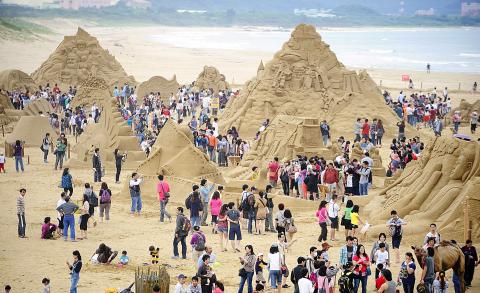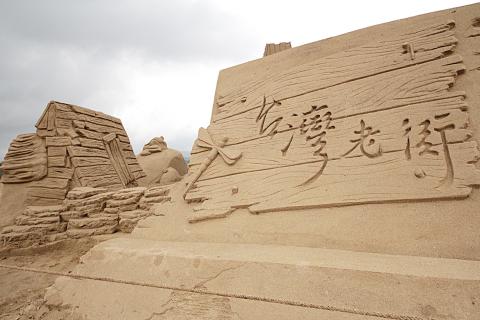While the hot weather has yet to bring out the miniskirts and shorts, the Fulong Beach in New Taipei City’s Gongliao District (貢寮) has been bustling with activity as 30 local and foreign sand sculptors gather to create art made from sand. Their 71 sand sculptures will be ready for exhibition when the 2014 Fulong International Sand Sculpture Art Festival (2014福隆國際沙雕藝術季) opens May 3. Now in its seventh year, the festival ends on June 30.
Co-organized by the Northeast and Yilan Coast National Scenic Area Administration, Tourism Bureau (東北角暨宜蘭海岸國家風景區管理處), and Fullon Hotels and Resorts (福容大飯店), the festival consists of a themed exhibition as well as international and national sculpture competitions. Participating sand artists — including Rusty Croft, who hosts US reality-television series Sand Masters — hail from 17 countries including India, Italy, Spain, the Netherlands, Bulgaria, Russia and the Czech Republic.
This year’s theme is “Voyage,” and visitors will surely have fun watching how the artists use sand to depict journeys across time and space — from the travels of Marco Polo along the Silk Road to Chinese mariner Zheng He’s (鄭和) 15th-century sea voyages.

Photo courtesy of Northeast and Yilan Coast National Scenic Area Administration
The international sand sculpture contest is designed to facilitate exchanges and boost the local sand-sculpting scene, says Lin Yu-shan (林毓珊), chief of the administration’s recreation section.
“When we first started in 2008, there were not enough professional sand sculptors in Taiwan. We had to invite wood sculptors to participate. After a couple of years, we felt it was important to bring in international sand artists to introduce skills, need knowledge and talent,” Lin says.
With cash prizes totaling close to NT$300,000, many previous competitors have returned, and a few were recruited to help the organizers to improve the festival experience, Lin says.

Photo courtesy of Northeast and Yilan Coast National Scenic Area Administration
The effort seems to have paid off as the number of visitors has grown from 40,000 in 2008 to 450,000 last year.
Contrary to common practice, the organizers don’t want to draw an excess number of visitors for fear that it will damage the natural environment, and visitors are encouraged to visit on weekdays.
Those who hope to appreciate the sand sculptures in pristine condition will want to visit early because the environmentally-friendly, non-toxic varnish that is used to help the works keep their form, cannot protect them from heavy rain and typhoons.

Photo courtesy of Northeast and Yilan Coast National Scenic Area Administration
To get there, visitors are encouraged to take the train to Fulong Station (福隆火車站) and walk five minutes to the beach. For those who drive, there will be free shuttle buses running between different parking spots and the festival site. For more information call (02)2499-1210, or visit the festival’s Web site at events.necoast-nsa.gov.tw/SandArt14/, which is set to go online today.

Photo courtesy of Northeast and Yilan Coast National Scenic Area Administration

That US assistance was a model for Taiwan’s spectacular development success was early recognized by policymakers and analysts. In a report to the US Congress for the fiscal year 1962, former President John F. Kennedy noted Taiwan’s “rapid economic growth,” was “producing a substantial net gain in living.” Kennedy had a stake in Taiwan’s achievements and the US’ official development assistance (ODA) in general: In September 1961, his entreaty to make the 1960s a “decade of development,” and an accompanying proposal for dedicated legislation to this end, had been formalized by congressional passage of the Foreign Assistance Act. Two

March 31 to April 6 On May 13, 1950, National Taiwan University Hospital otolaryngologist Su You-peng (蘇友鵬) was summoned to the director’s office. He thought someone had complained about him practicing the violin at night, but when he entered the room, he knew something was terribly wrong. He saw several burly men who appeared to be government secret agents, and three other resident doctors: internist Hsu Chiang (許強), dermatologist Hu Pao-chen (胡寶珍) and ophthalmologist Hu Hsin-lin (胡鑫麟). They were handcuffed, herded onto two jeeps and taken to the Secrecy Bureau (保密局) for questioning. Su was still in his doctor’s robes at

Last week the Democratic Progressive Party (DPP) said that the budget cuts voted for by the China-aligned parties in the legislature, are intended to force the DPP to hike electricity rates. The public would then blame it for the rate hike. It’s fairly clear that the first part of that is correct. Slashing the budget of state-run Taiwan Power Co (Taipower, 台電) is a move intended to cause discontent with the DPP when electricity rates go up. Taipower’s debt, NT$422.9 billion (US$12.78 billion), is one of the numerous permanent crises created by the nation’s construction-industrial state and the developmentalist mentality it

Experts say that the devastating earthquake in Myanmar on Friday was likely the strongest to hit the country in decades, with disaster modeling suggesting thousands could be dead. Automatic assessments from the US Geological Survey (USGS) said the shallow 7.7-magnitude quake northwest of the central Myanmar city of Sagaing triggered a red alert for shaking-related fatalities and economic losses. “High casualties and extensive damage are probable and the disaster is likely widespread,” it said, locating the epicentre near the central Myanmar city of Mandalay, home to more than a million people. Myanmar’s ruling junta said on Saturday morning that the number killed had